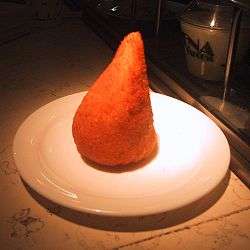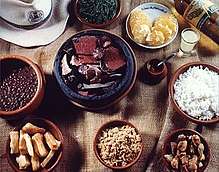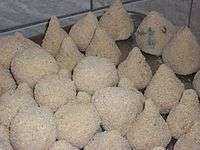Coxinha
Coxinha (Portuguese: [koˈʃĩj̃ɐ], little [chicken] thigh) is a popular food in Brazil consisting of chopped or shredded chicken meat, covered in dough, molded into a shape resembling a teardrop, battered and fried.
 The typical look of a Brazilian coxinha. It is eaten in a large variety of sizes | |
| Place of origin | Brazilian |
|---|---|
| Region or state | São Paulo, São Paulo state |
| Main ingredients | Chicken (sometimes cooked unripe jackfruit), broth, flour, sometimes potatoes |
History
Coxinhas were originally made with a chicken thigh, which its traditional shape is meant to resemble. In its modern processed form it may have originated in Limeira in the 19th century.[1]
In the book Stories & Recipes, Nadir Cavazin says that the son of Isabel, Princess Imperial of Brazil (1846-1921) and Prince Gaston, Count of Eu, a child who lived in seclusion for having mental problems, had a favorite dish, chicken, but only ate the thigh. One day, not having enough thigh, the cook decided to turn a whole chicken into thighs, shredding it and making the filling for a flour dough shaped into a drumstick. The child endorsed the results. Empress Teresa Cristina, when she was visiting him, could not resist the tasty delicacy; she liked it so much she requested that the master of the imperial kitchen learn how to prepare the snack.
Preparation
 |
| Part of a series on |
| Brazilian cuisine |
|---|
| Types of food |
| See also |
|
The coxinha is based on dough made with wheat flour and chicken broth and optionally mashed potato, which is filled with shredded spiced chicken meat, or a whole chicken thigh. The filling consists of chicken, catupiry cheese or requeijão and onions, parsley and scallions, and occasionally tomato sauce, turmerice. The coxinha is coated in batter, then in bread crumbs or manioc flour and deep fried. It is shaped to roughly resemble a chicken leg. The dough used to coat the filling is generally prepared with the broth of the chicken, enhancing the flavor of the coating.
Variations
Different variations of the original are becoming more prevalent today – for example, the coxinha mineira, for which the filling includes maize, so named because maize is deemed a culinary tradition in the state of Minas Gerais, as well as areas where the caipira and sertanejo dialects are spoken. Cheese coxinhas are also very common in snack bars. In Curitiba, chicken coxinhas filled with cheddar and Araucaria nuts can be found in local restaurants. To mark the cheese they usually have a toothpick where the bone would be in a chicken coxinha.

Other unconventional ingredients, generally used for home-made coxinhas made by aficionados, include peas, chopped button mushrooms, palmheart, carrot, cooked and seasoned cashew apples, unripe jackfruit or unripe breadfruit, as well as whole-wheat flour batter or even a vegetarian version of either textured vegetable protein (soy meat) or falafel with appropriate seasonings so its taste resembles a traditional coxinha more closely. These variants are rarely found in snack bars.
Related foods
Coxinha literally means "little thigh", and it is how deep fried chicken legs are informally named in Brazil (coxa frita means a deep fried chicken leg, while sobrecoxa frita stands for a deep fried upper drumstick; It is not uncommon for people having a strong preference for certain poultry cuts over others). Battered and deep fried chicken breast pieces, for example, are generally called by a name of English influence, nugget.
Political term
Starting in São Paulo, by supporters of the Worker's Party (PT) and radical left wingers, the word "coxinha" became a slur, to these left wingers, now referring loosely to people who display a lavish lifestyle and hold conservative political opinions.[2]
See also
- Croquette
- Arancini
- Cuisine of Brazil
- List of Brazilian dishes
References
- "Brazilian Bakery". google.com.
- Aragão, Alexandre (22–28 April 2012). "Coxinha? É de comer?". Issuu. Retrieved 2020-06-20.CS1 maint: date format (link)
External links
- Coxinha recipe at SouthAmericanFood.about
